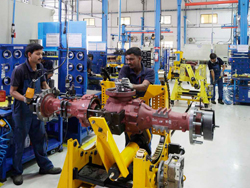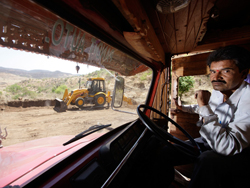
Managing Director
ZF India
ZF Steering Gear (India) Ltd (ZF India), which was incorporated in 1980 as a joint venture, ZF Friedrichshafen AG, is a pioneer in manufacture and supply of integral hydraulic power steering system in India and has a joint venture with ZF Lenksysteme GmbH. Piyush Munot, Managing Director, ZF India, discusses the economic imperatives of advanced manufacturing industries including earthmoving and construction equipment.
Welcoming the new government, the entire country is hoping to wake up to a new India! An India that focuses on progress and overall development which will foster the economic and social growth.
Besides worthy governance, what is required is a better formulation system of policies, better management of technology with regards to innovation and most importantly job growth.
With a new regime in place, the nation expects the Narendra Modi government to bring in reforms extensively to turn the economic growth upwards.
When we talk about the auto component industry, we can positively say that it forms a major part of the Indian economy. The auto industry as a whole has been giving the Indian economy a well progressive chart, adding up adequately to the country’s GDP.
For the nation to stay competitive in the global market place and create employment opportunities for the country’s young workforce, it is vital for India to transform its manufacturing sector.
 Developed countries or first world countries are majorly innovation-driven, characterised by high per capita income levels, high standards of living and various industries with advanced technology and the ability to manufacture new and unique products and technology . For India to be counted among these countries, we have a long way to go.
Developed countries or first world countries are majorly innovation-driven, characterised by high per capita income levels, high standards of living and various industries with advanced technology and the ability to manufacture new and unique products and technology . For India to be counted among these countries, we have a long way to go.
The primary characteristics of advanced manufacturing industries are high R&D spend, use of futuristic technologies, requirement of highly skilled manpower, and drivers of innovation and productivity in other sectors.
Issues related to factors of production, such as land, labour, capital and power, are amongst the most critical challenges that the new government will have to deal with. Inflation and need for tax reforms were also cited as other immediate concern areas.
India has low indigenous manufacturing capabilities in diverse sectors. Developing India’s advanced manufacturing capabilities will not be easy. Strong challenges from other nations, inconsistent engineering and workforce training systems, and the absence of a good quality talent ecosystem continue to haunt the nation.
While efforts to develop the advanced manufacturing sector will largely depend on private initiative, national-level initiatives are needed on R&D investment, taxes, trade and mainly infrastructure.
The three important factors will be crucial to bring about a dynamic change: industry, government and academia. These three have their task cut out in days to come. At city and cluster levels, industry and academia should work closely together in innovation, invest and stay focused in local industry clusters, drive trade and build the necessary skills base to revamp and build a robust manufacturing sector.
It’s high time that industry should look beyond ‘low cost’, focus on technology-driven innovation, increase value addition, and create skill development institutes by engaging with academia.
Current status
 The demand for mining and construction equipment, to a large extent, mirrors macro-economic indicators; consequently, the high interest rate regime, slowdown in infrastructure investments, liquidity crunch and several regulatory roadblocks have led to a sharp decline in demand for mining and construction equipment (MCE) during the past three-four quarters, with the slowdown being particularly pronounced since April 2012. Deferment in private projects and slow pace of infrastructural investments were among the key reasons hurting construction equipment volumes while curb on mining in several geographies has impacted the demand for mining equipment.
The demand for mining and construction equipment, to a large extent, mirrors macro-economic indicators; consequently, the high interest rate regime, slowdown in infrastructure investments, liquidity crunch and several regulatory roadblocks have led to a sharp decline in demand for mining and construction equipment (MCE) during the past three-four quarters, with the slowdown being particularly pronounced since April 2012. Deferment in private projects and slow pace of infrastructural investments were among the key reasons hurting construction equipment volumes while curb on mining in several geographies has impacted the demand for mining equipment.
Key drivers
For the earthmoving and construction equipment (ECE) industry the industry estimates the demand for equipment to expand to over 91,000 units in 2016 from around 50,000 units in 2011. For the components providers to the ECE Industry following factors are the key driving points.
Robust economic development: India’s 12th Five-Year Plan is targeting 11 per cent growth for the earth moving and construction sector up from 7.8 per cent in the previous plan.
Infrastructure growth: Substantial infrastructure investments of Rs. 45 trillion under the 12th Plan will drive higher demand for equipment.
Growing OEM presence: India offers significant potential as an OEM hub due to its lower costs and the availability of skilled labour.
Higher FDI in construction: Increased construction activities create favourable conditions for foreign direct investment in the earthmoving and equipment sector
Challenges
There have been some challenges facing the infrastructure sector. For example, there has been a delay in commencing of infrastructure projects due to time and cost overruns; added to this is shortage of funds. Environmental concerns and delay in government clearances also is a major challenge. There is also a lack of structured regulatory and policy framework for PPP models which needs to be addressed.
Moreover, there is a lack of structured regulatory and policy framework when it comes to the PPP framework.
While infrastructure challenges continue to impede the growth of the ECE industry, some other areas which require urgent attention in the sector are:
Financing: Currently, in India, OEMs offer limited financing options to buyers. Creating easy access to finance and relooking at the payment terms would be an important factor in improving the overall performance of the ECE industry.
Skilled manpower: Skilled manpower is an essential factor to ensure safe and efficient operations of construction equipment. This will especially become crucial if the industry’s projected growth materialises.
Component manufacturers: Varying demand from OEMs due to the adverse market conditions has put tremendous pressure on the utilisation of the expanded capacities of the supplier base. It is imperative that in the future OEMs and Suppliers coordinate and ramp up capacity to meet future market demands.
Technology advancement: While many would argue that India is not matured enough to move to the next level of Technology in the ECE market. It is mainly due to the price and not so much due to low technology adoption by consumers. OEMs face a huge hurdle to get the price-value equation right for technologically advanced product range. This becomes even more pronounced because currently the market size is quite low and it doesn’t make business sense for the OEM to even partly absorb the price rise.
Keeping these factors in mind, the new government should look at implementing the National Manufacturing Policy effectively. While encouraging the private and public sector to build advanced technical capabilities, it should right way prioritise indigenisation of the Railways, defence and power at war footing.
The creation of national industrial manufacturing zones and industrial corridors should kick up speed. The academia should help industry create an R&D ecosystem and enhance our intellectual property resources.











